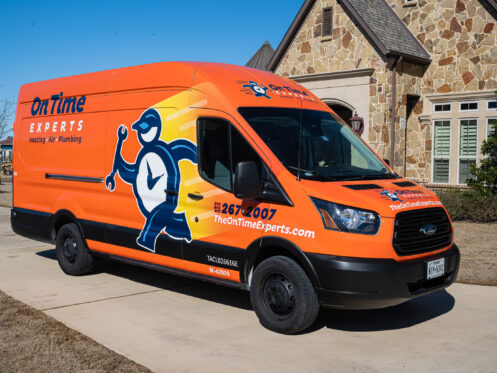If you’re like most people, you’re probably used to relying on a storage-tank water heater for hot water. They’re the most popular water heater type in the US. However, they’re not your only option. You may also choose a tankless water heater for your home. You’ll need to know how to choose the right size system to do that. Here’s precisely how to do it.
Tankless Water Heater Size Considerations
When you buy a storage-tank water heater, your primary sizing concern is how many gallons of water it holds. They let you use as much hot water as you want, in as many places as possible, until the supply runs out.
Tankless models don’t store water at all, however. They produce it on demand when you need it. To do that, a tankless has a demand sensor and a high-power heating element. So, sizing a tankless involves a few different variables than the ones you’re used to. One of them is the flow rate the tankless can produce. That is the volume of hot water, measured in gallons per minute (GPM), that the tankless outputs. If you buy an undersized tankless, you’ll face hot water shortages during periods of high demand.
The other variable is the temperature rise your home requires to maintain your desired water temperature. You must combine both factors when choosing a tankless water heater. Your required temperature rise directly affects the flow rate a given tankless water heater can sustain. The lower your incoming water temperature, the harder the tankless water heater must work to heat it, lowering hot water output from the system.
Determining Temperature Rise
First, you must figure out your home’s incoming water temperature. In the Dallas-Fort Worth area, most homes have an average incoming water temperature of around 65 degrees Fahrenheit. In the summer, your incoming water may get as hot as 71 degrees. In the winter, it may drop as low as 59 degrees.
In most homes, experts recommend a hot water temperature of 120 degrees. That’s hot enough for most purposes without posing much danger of scalding. As a result, your home likely requires a tankless heater capable of a 55-degree average temperature rise. You’ll find that value listed as a given tankless’s ΔT. Most models will chart their rated flow rates at various common ΔT values.
Determining Flow Rate Requirements
Your next task is to figure out how much hot water your home requires at any given time. That’s mostly a function of how many places you plan to use hot water simultaneously. So, start by thinking about your daily hot water use. Do you routinely use hot water in several parts of your home at the same time? Common reasons include showering and running a washing machine or a dishwasher at the same time. The idea is to determine the maximum theoretical hot water flow rate your home requires. As you do this, it’s a good idea to list your water fixtures and appliances alongside their flow rates. For a ballpark estimate, you can use the data in the following list:
- Standard shower fixture – 2 GPM
- Low-flow shower fixture – 1.5 GPM
- Small bathroom faucet – .5 GPM
- Large bathroom faucet – 1.5 GPM
- Kitchen faucet – 2 GPM
- Bathtub faucet – 4 GPM
- Dishwasher – 2 GPM
- Washing machine – 1.5 GPM
Of course, the figures listed above are estimates. To be as precise as possible, you should determine the flow rates of your home’s specific appliances and fixtures. You can consult your appliances’ owner manuals or manufacturer websites to find their flow rates. As for your fixtures, you can measure their flow rates with a gallon-sized bucket and a stopwatch. Once you have the necessary data, add the flow rates of the appliances and fixtures you plan to use simultaneously. You’ll need a tankless capable of that flow rate at your required ΔT.
What if There’s No Tankless That Meets Your Requirements?
If yours is a high-demand household, you may end up with a required flow rate that no tankless can sustain. That’s common in larger homes or those housing large families. In those situations, you could have multiple people showering while others use hot water elsewhere. Fortunately, there is a way to use tankless water heaters to meet that kind of demand. It just takes a bit of preplanning.
In high-demand situations, you can divide your home into multiple hot water zones. For example, you may include your primary bathroom and washing machine in one zone and everything else in another. The goal is to lower the maximum flow rate demand from each zone to a more reasonable level. Then, you’d install multiple tankless systems, one serving each zone. While doing so may cost more upfront, it offers a no-compromises approach to meeting your home’s hot water needs.
Other Things To Consider
As you search for the correct size tankless water heater, you’ll also have to choose between gas-fired and electric models. Gas-fired models are generally the better option if your home can support them. For one thing, they’re drastically cheaper to operate. For another, they’re capable of far higher flow rates. If your home doesn’t have a natural gas supply, it may even be worth adding one for your new tankless heater.
If you must use electric tankless water heaters, you should know a few things. One is that you’ll likely need multiple heaters, even if you don’t have unusually high hot water demand. Fortunately, electric heaters are cheaper than gas models, which takes some of the sting out of needing more than one. You should also know you can install small electric on-demand heaters for individual fixtures or appliances.
It is also possible to use small electric tankless water heaters to supplement the production of a gas-fired model. That can be a solution if you have an appliance you only occasionally use that would otherwise overstretch your tankless. Then, you wouldn’t have to go through the extra expense of splitting your home into multiple zones.
Local Tankless Water Heater Installation
Since our founding in 1965, On Time Experts has been the go-to provider of water heaters in Dallas-Fort Worth, TX. We offer both traditional storage tank models and the latest tankless options. We also offer slab leak repair, sewer repair and replacement, kitchens and bathrooms, and sump pumps. If your home needs HVAC services, we provide affordable installation, repair, and maintenance. Plus, we offer some of the best guarantees in the business.
We guarantee same-day service, or you’ll pay no service fee. Our apples-to-apples guarantee gives you a year to find a better system price, which we’ll match with a $100 bonus. We also guarantee to respect your home and always leave it in better condition than we found it. Our technicians are even drug—and background-checked for your safety. So, if you need a tankless water heater in Dallas-Fort Worth, call On Time Experts today!

